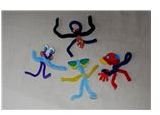Teaching Special Ed Students Good Social Skills
Role Plays and Examples
Often students learn communication, social skills and teamwork through the simple acts of watching others and practicing their skills under guidance from a teacher. Some students, such as those with an intellectual disability, may need a teacher to very clearly explain what the key aspects of their behavior or their communication are, so that a student can learn which parts of an example or role modeling situation they should focus upon.
Set up lots of opportunities to practice in simulated real-life situations and during in class tasks. For example:
- Sitting at a pretend bus stop and practicing keeping the body still and talking only about appropriate topics.
- Practicing ordering a drink and a meal from an in-class cafe.
- Showing clearly what counts as ’too close’ when sitting next to a stranger in a movie theater.
- Pretending to buy an item at a classroom ‘store’.
- Asking a ’librarian’ for help borrowing a book.
- Playing a board game in a small group.
- Completing a jigsaw puzzle with a partner.
- Creating a simple story with a partner using digital photos about a class excursion.
These in-class examples give students the chance to practice, watch others and learn from mistakes in a supported and safe environment before testing out their skills in public. This gives a better chance of maintaining self esteem and confidence, as well as avoiding any unexpected social skills breakdowns.
Pipe Cleaner People
The pipe cleaner people in the image to the right are a great ’low-tech’ way of continuing to practice social, communication and teamwork skills. They can be used to:
-
Create characters - ‘Assertive Alex’, ‘Bashful Bill’, ‘Positive Paul’ and ‘Shy Shauna’.
-
Act out social situations - practice dialogue, set up problem situations and resolve them, show what to do when social situations go wrong.
-
Provide the basis for a digital story; set up a frame-by-frame story using the pipe cleaner people and some simple text, then take digital photos of each frame.
For older students, pipe cleaner people are the perfect solution to that age-old special education dilemma–how to use play skills in an age appropriate way–while encouraging learning in a way that is not demeaning or insulting to your students.
To make the pipe cleaner people, simply twist together some bright pipe cleaners, one for the body and another for the arms. Add some extra features using cut outs of cardboard (store bought, or make your own). Think about the particular features that will allow you to create a personality for each pipe cleaner person. You can make them yourself, or involve your students in creating their own characters.
